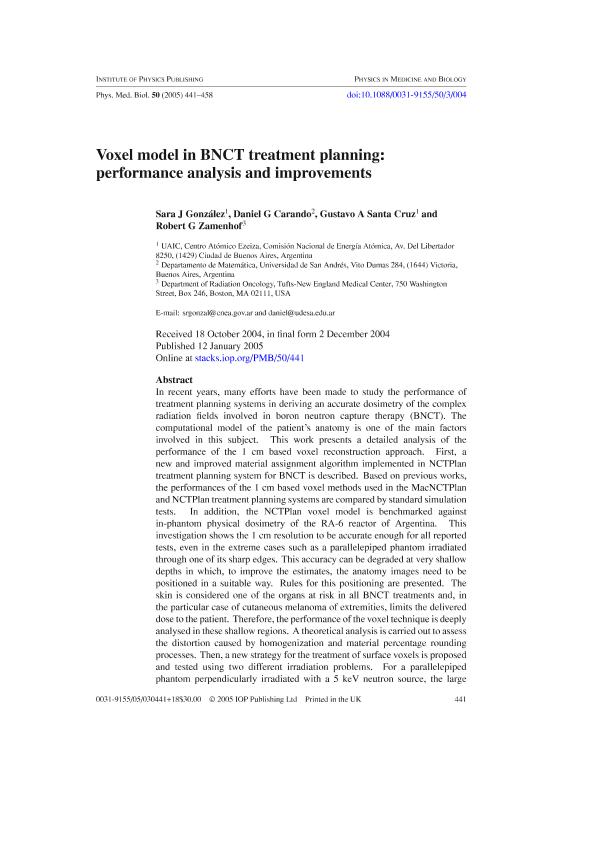Mostrar el registro sencillo del ítem
dc.contributor.author
González, Sara Josefina

dc.contributor.author
Carando, Daniel Germán

dc.contributor.author
Santa Cruz, Gustavo Alberto

dc.contributor.author
Zamenhof, Robert G.
dc.date.available
2022-02-03T00:27:30Z
dc.date.issued
2005-01
dc.identifier.citation
González, Sara Josefina; Carando, Daniel Germán; Santa Cruz, Gustavo Alberto; Zamenhof, Robert G.; Voxel model in BNCT treatment planning: Performance analysis and improvements; IOP Publishing; Physics In Medicine And Biology; 50; 3; 1-2005; 441-458
dc.identifier.issn
0031-9155
dc.identifier.uri
http://hdl.handle.net/11336/151201
dc.description.abstract
In recent years, many efforts have been made to study the performance of treatment planning systems in deriving an accurate dosimetry of the complex radiation fields involved in boron neutron capture therapy (BNCT). The computational model of the patient's anatomy is one of the main factors involved in this subject. This work presents a detailed analysis of the performance of the 1 cm based voxel reconstruction approach. First, a new and improved material assignment algorithm implemented in NCTPlan treatment planning system for BNCT is described. Based on previous works, the performances of the 1 cm based voxel methods used in the MacNCTPlan and NCTPlan treatment planning systems are compared by standard simulation tests. In addition, the NCTPlan voxel model is benchmarked against in-phantom physical dosimetry of the RA-6 reactor of Argentina. This investigation shows the 1 cm resolution to be accurate enough for all reported tests, even in the extreme cases such as a parallelepiped phantom irradiated through one of its sharp edges. This accuracy can be degraded at very shallow depths in which, to improve the estimates, the anatomy images need to be positioned in a suitable way. Rules for this positioning are presented. The skin is considered one of the organs at risk in all BNCT treatments and, in the particular case of cutaneous melanoma of extremities, limits the delivered dose to the patient. Therefore, the performance of the voxel technique is deeply analysed in these shallow regions. A theoretical analysis is carried out to assess the distortion caused by homogenization and material percentage rounding processes. Then, a new strategy for the treatment of surface voxels is proposed and tested using two different irradiation problems. For a parallelepiped phantom perpendicularly irradiated with a 5 keV neutron source, the large thermal neutron fluence deviation present at shallow depths (from 54% at 0 mm depth to 5% at 4 mm depth) is reduced to 2% on average. Reassigning fluence values in the case of this phantom in angular position produced the maximum deviation in the thermal fluence to decrease from 140% to 23% at the surface of the phantom. Thus, even for the largest deviations, obtained by intentionally placing the phantom in the most disadvantageous position with respect to the voxel grid, the reassignment shows very good performance. Since these results substantially improve the performance of the 1 cm based voxel model in surface boundary regions, the proposed strategy will be implemented in future versions of the NCTPlan code.
dc.format
application/pdf
dc.language.iso
eng
dc.publisher
IOP Publishing

dc.rights
info:eu-repo/semantics/openAccess
dc.rights.uri
https://creativecommons.org/licenses/by-nc-sa/2.5/ar/
dc.subject
Voxel model
dc.subject
BNCT treatment
dc.subject.classification
Otras Matemáticas

dc.subject.classification
Matemáticas

dc.subject.classification
CIENCIAS NATURALES Y EXACTAS

dc.title
Voxel model in BNCT treatment planning: Performance analysis and improvements
dc.type
info:eu-repo/semantics/article
dc.type
info:ar-repo/semantics/artículo
dc.type
info:eu-repo/semantics/publishedVersion
dc.date.updated
2021-12-03T20:49:25Z
dc.journal.volume
50
dc.journal.number
3
dc.journal.pagination
441-458
dc.journal.pais
Reino Unido

dc.journal.ciudad
Londres
dc.description.fil
Fil: González, Sara Josefina. Comisión Nacional de Energía Atómica; Argentina. United Automobile Insurance Company; Argentina
dc.description.fil
Fil: Carando, Daniel Germán. Consejo Nacional de Investigaciones Científicas y Técnicas. Oficina de Coordinación Administrativa Ciudad Universitaria. Instituto de Investigaciones Matemáticas "Luis A. Santaló". Universidad de Buenos Aires. Facultad de Ciencias Exactas y Naturales. Instituto de Investigaciones Matemáticas "Luis A. Santaló"; Argentina. Universidad de San Andrés; Argentina
dc.description.fil
Fil: Santa Cruz, Gustavo Alberto. Comisión Nacional de Energía Atómica; Argentina. United Automobile Insurance Company; Argentina
dc.description.fil
Fil: Zamenhof, Robert G.. Tufts-New England Medical Center; Estados Unidos
dc.journal.title
Physics In Medicine And Biology

dc.relation.alternativeid
info:eu-repo/semantics/altIdentifier/url/https://iopscience.iop.org/article/10.1088/0031-9155/50/3/004/pdf
dc.relation.alternativeid
info:eu-repo/semantics/altIdentifier/doi/https://doi.org/10.1088/0031-9155/50/3/004
Archivos asociados
